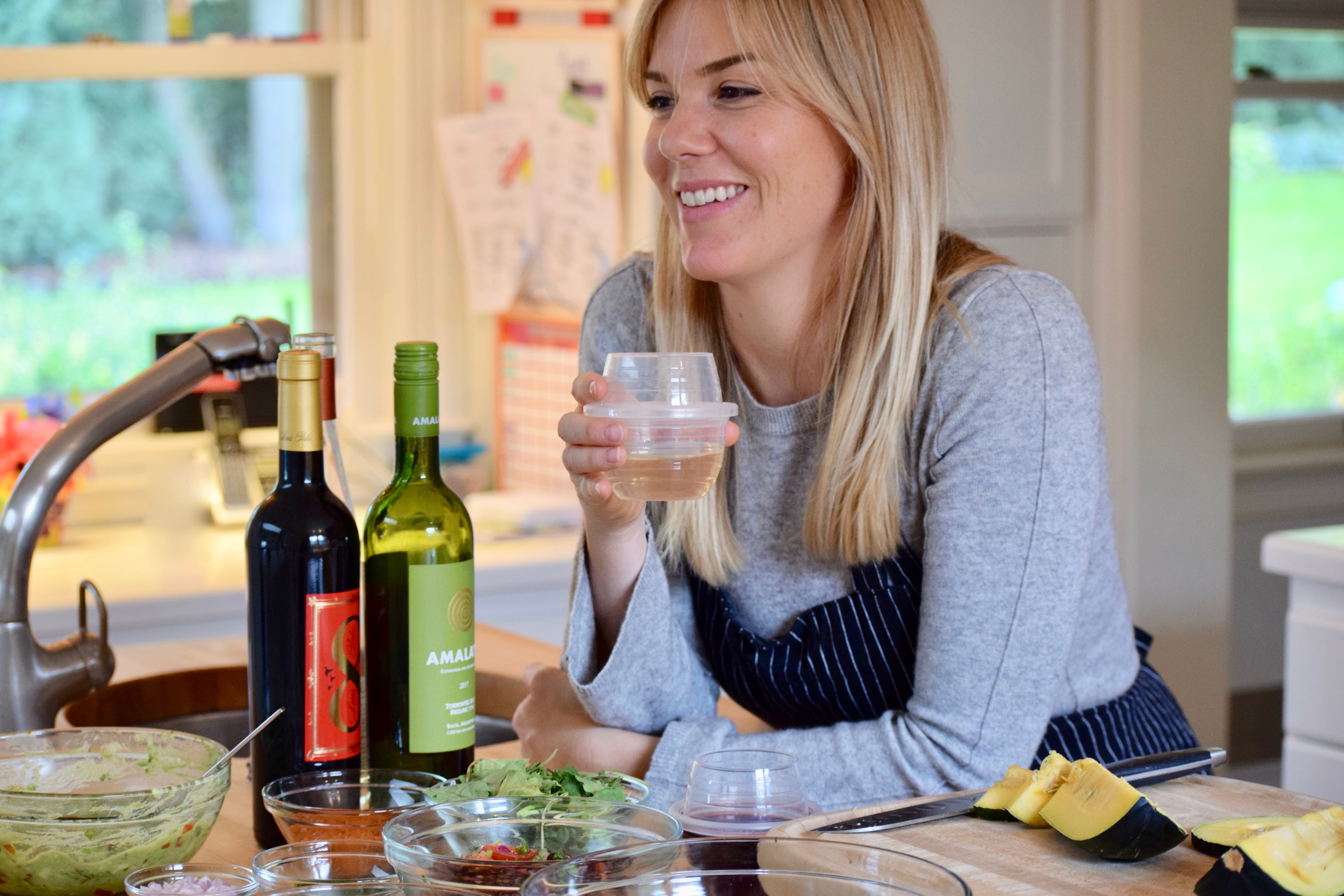
In the Spotlight: HaloVino founder Jessica Bell
For some people, the “American dream” is all about buying a house. Maybe it’s the Millennial in me, but buying a house holds no appeal.
For me, the American dream has always been about entrepreneurship. See a problem, develop a product that fixes it, and sell it by the million. Become an inventor.
Of course, there’s a lot more to it than that, and that’s why I was thrilled to interview Jessica Bell for the first issue of Doyenne’s Audacity in Action “In the Spotlight” series featuring entrepreneurs that Doyenne has funded.
When I first met Jessica, she had already spent two years working on her invention — a stackable, shatterproof, and affordable plastic wine glass that preserved the classic wine glass shape. That was 2016, when she was just about to begin production.
Now HaloVino is available from an ever expanding list of retailers, including Walmart.com, national wine retailer BevMo! and select Total Wine & More stores around the country. HaloVino has also landed deals to supply the plastic wine glasses to several sports and performing arts venues around the country, including Fiserv Forum in Milwaukee and the American Airlines Arena in Miami.
The following is an edited transcript of my conversation with Jessica about her experiences turning her product idea into a business and what’s next for HaloVino.
Your business has stayed true to the original vision — how do we enjoy wine when we can’t use glass? — but now you’re broadening out. Talk me through that?
I found that the more you dive into a market, you discover other problems that are even bigger than the one you set out to solve. And for us, that bigger problem was single-use plastic waste. I realized we could really be the solution to this because we’re fully dishwasher safe but at a low price-point. And because we have ounce signs etched into the glass, vendors still know how high to pour.
We expect consumer habits to shift away from single-use plastic in all scenarios. So you’ll have to buy your first glass (whether you’re drinking wine or beer or anything) or bring your own. Just like we bring our water bottles and grocery bags.
We’re an on-the-go culture. We’re not going to give that up — so we have to think about how we’re going to continue this lifestyle that we enjoy without having such a damaging cost to the environment.
That’s also why you’re launching a second product, right?
By mid-year this year we’ll have HaloTotes — water-resistant, dishwasher safe totes that promote this lifestyle. You can put the cup back in the tote and it won’t get your purse or backpack wet.
So the last time we talked, it was just you — no team. Now you’ve got one almost-full-time employee and four other part-time contractors. What have you learned from scaling up your team?
The biggest takeaway has been that it takes a lot of resources and time to hire someone, so you have to make sure it’s a good fit. My first hire was a woman right out of college, and she left kind of by surprise, because she wasn’t earning enough money. If I had known that, I might have been able to increase her salary. I had put a lot of resources into hiring her and training her.
So now, when possible, I recommend working on a project basis, and then figure out if there’s a good fit.
I definitely prefer working on a per-project basis as a freelancer — it’s a nice test-run of a working relationship.
We work together with people. It’s a big part of our lives. Your work relationships should be important and valuable and a big part of your personal happiness. If you have to make shotgun decisions about them, they can backfire.
You’ve raised almost $600,000 between equity, debt, and grants (and $50K from Doyenne!). When we first spoke a few years ago, you were reluctant to bring on funding partners. How has your perspective shifted?
I’ve learned that success as an entrepreneur is more about the person and the market rather than the idea. You think you know what the solution is, but once you get in, you learn so much. You need to be a good problem solver. Be flexible. Be able to completely pivot.
You can fail for being too conservative in raising capital. If you aren’t well capitalized, you’re so cash strapped. One wrong decision and you’re done. But I’m glad I didn’t raise a ton immediately — I would have spent the money in the wrong places.
What did you think of the fundraising process?
You have to have all the buzzwords. For example, investors are always like, “Do you have a patent?” And I think, “Do you really know what that means? Yes I do have a patent. Do you feel better?” A lot of the people who are investing in companies haven’t done their own companies, or certainly not the company they’re investing in.
I had a bunch of bad experiences raising money as a woman. I have a big vision for what I want to do, and a lot of times I was told to stay in your lane, you’re a one-cup company, just do that. I get that, you need to focus, but you have to have vision and a plan to get there. I’m never going to have a big company with multiple projects if I don’t imagine it first.
I was really angry and I wanted to stick it to them. But I thought — just put your head down, keep working, and show them in the best way possible.
That’s what I have appreciated about working with Doyenne. When I talk to Amy, she doesn’t shoot me down. She says, “I love it. Let’s figure out when and how it makes sense.” In the future, if things go well, I’d like to be on the other side of the table investing. I just know there are certain questions I would ask.
So you’re well financed for the next 18 to 24 months. What does your next phase of growth look like? How are you going to mobilize that funding?
We’re going to do a digital, full-color printing system, with a resin that is melted into the glass. It allows wholesalers to put their own logo on the glass, while still making it easily recyclable. That’s coming online in February. Between regular glasses and printed glasses, we’ll be looking to scale those. And I’m looking at one other line extension. Apart from that, we have a wine dispenser that’s patent-pending. It’s a ways off, but having been through the patent process with the original wine glass, I know how long the development process takes for a new product. If we don’t start now, it’ll be five years before we get the next one going.
The first time we spoke, you gave me a glimpse of the gauntlet you ran to get the first patent. So you’re doing it again?
Getting a patent is kind of like having a kid, you say you’ll never do it again, and then whoops, you’re pregnant again! I thought I’d never go down this route again. But now I am. But this time, we paid a little extra money, and instead of waiting three years, it’ll just be five months. I’ve learned to not sink too many resources into a product until you have the patent. This time around, we did enough to write the patent, but not so much that it’s ready to go to market.
But at the end of the day, you think the patent is worth it?
It’s a necessary evil if you’re going to have something novel. People aren’t going to replicate what you do until you start making money. Once that happens, we’ll have protection in place with the patent. It will allow us to grow our market share and sell at a higher price. We can’t compete with the Solo’s of the world without one. They could easily rip us off.
It’s so expensive to build a mold (for manufacturing), you can’t afford to have a competitor come in and copy you. That’s why I won’t develop the wine dispenser on my own if I don’t have a patent or a partner with a deep pocketbook.
Ok, last question. Is there a number or statistic about your company that you’re especially proud of?
Probably growing at 350 percent year-over-year. You think, HOW will I sell that many cups?? Then you just slowly do. It’s the little things that all add up. I think we’ve sold or made at least 250,000 glasses. We’re definitely a proven concept. Nobody says they leak or don’t work. So I think we’re doing pretty good.

